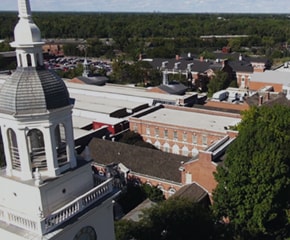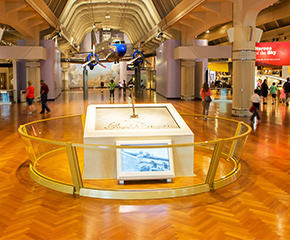
The DC-3: Changing Passengers’ Expectations
12 artifacts in this set
This expert set is brought to you by:
The staff at The Henry Ford
"United Air Lines Presents The Mainliner," 1937
Brochure
United Airlines promoted its new Douglas DC-3 "Mainliners" in this 1937 brochure. With a range of 1,500 miles, the Mainliners flew from New York to San Francisco in less than 16 hours with only three stops along the way. The planes came in three configurations: standard 21-passenger coaches, sleepers with folding berths for 14, and "Skylounges" with deluxe swiveling seats.
North Central Airlines Brochure, circa 1970
Brochure
North Central Airlines was founded in Clintonville, Wisconsin, in 1944 but was headquartered in Minneapolis for most of its existence. As its name suggests, the airline served cities in the north central part of the U.S. including Minneapolis, Denver, Chicago, and Detroit. The company's mascot, Herman the duck, featured prominently in its logo. North Central merged with Southern Airways in 1979 to form Republic Airlines.
North Central Airlines' 1939 Douglas DC-3 in Flight, circa 1975
Photographic print
Minneapolis-based North Central Airlines bought DC-3 number N21728, built in 1939, from Eastern Airlines in 1952. After 13 years in passenger service, North Central converted the airplane into a VIP transport in 1965. The durable DC-3 logged almost 85,000 flight hours and traveled some 12 million miles over its 36-year career. It was donated to The Henry Ford in 1975.
Cockpit of the 1939 Douglas DC-3 Airplane, Photographed in 2003
Digital image
The Douglas DC-3, first flown in 1935, made use of several advancements in aircraft design. Internal bracing for the wings allowed for streamlined surfaces. Engine cowlings and retractable landing gear reduced drag. Improved engines increased range. The result was a rugged, stable airplane easy for pilots to handle. By 1939, DC-3 planes carried 75 percent of U.S. air travelers.
Cockpit Controls inside a Ford Tri-Motor Airplane, 1927-1930
Photographic print
With its large, thick wing, the Ford Tri-Motor was very stable in flight. The three engines provided an excellent safety margin. The plane could fly well with two motors, and it could maintain level flight with only one. Cockpit design was efficient. Dual controls allowed either the pilot or co-pilot -- or, in bad weather, both -- to fly the craft.
Passengers Seated Inside a Ford Tri-Motor Airplane, October 1928
Photographic print
Americans initially wondered if air travel was safe. Fatal crashes by barnstorming pilots were well-publicized, and wood and cloth airplanes did not inspire confidence. But when Henry Ford began making planes, the industrialist's solid reputation eased people's fears. The all-metal Tri-Motors were rugged, dependable and safe. By the late 1920s these planes were the backbone of the budding airline industry.
Stout Air Transport 2AT-2 Airplane, "Maiden Dearborn" at Ford Airport, 1925
Photographic print
The Stout 2AT airplane, designed by William B. Stout, first flew in February 1924. It had a cruising speed of 100 miles per hour, a range of 500 miles, and a capacity of six passengers or 1,500 pounds of freight. The plane in this photo was the first built at Stout's factory in Dearborn -- which explains its pun name, Maiden Dearborn.
American Airlines DC-3 Flagship Model Airplane Kit, circa 1945
Model airplane
Model airplanes have been a popular hobby since the 1920s. Early modelers built from scratch, but entrepreneurs soon saw the business possibilities in making and selling model kits. Balsa wood was a favorite building material due to its strength, light weight, and the ease with which it could be shaped.
1939 Douglas DC-3 Airplane
Airplane
The Douglas DC-3, introduced in 1936, carried 21 passengers -- enough to fly profitably without relying on subsidies from air mail contracts. While the DC-3's economy appealed to airlines, its rugged construction and comfortable cabin attracted passengers. More than any other aircraft, the DC-3 ushered in the era of dependable, long-distance air travel in the United States.
TWA Experimental Anti-Snow Static Loop Antenna, 1937
Radio antenna
Airport radio navigation beacons required pilots to listen for Morse code patterns to hold the correct course--notoriously difficult during storms. In 1936, Transcontinental & Western Air introduced an anti-snow directional antenna which could be used, in high-static situations, to "home in" on airport radio signals. This loop was housed in a sleek metal enclosure, protecting it from the elements.
North Central Airlines Flight Log Sheet #19260, August 25, 1971
Log (Record)
Airplanes require careful maintenance, and each flight must be thoroughly documented in a log book. This log, for a 1971 flight by Douglas DC-3 N21728, records everything from crew members' names, to flight times, to the engines' fuel and oil pressures. Equipment problems and subsequent repairs are recorded as well.
North Central Airlines Douglas DC-3 Airplane Flight Log Binder, Presented to The Henry Ford on May 28, 1975
Log (Record)
Airplanes require careful maintenance, and each flight must be thoroughly documented in a log book. This book, for the final flights of the Douglas DC-3 in The Henry Ford's collection, records everything from crew members' names, to flight times, to the operating temperatures of the engines' cylinder heads. Equipment malfunctions and subsequent repairs are noted as well.


